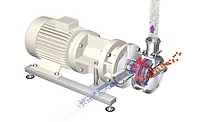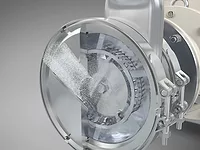Effective Dispersion Efficiency
Without Grinding Media
In 2011, NETZSCH-Feinmahltechnik GmbH began technical development and engineering of the OMEGA® Economic Dispersionizer for de-agglomeration, disaggregation and delamination of primary particles, as well as emulsification. In April 2013, NETZSCH Premier Technologies, LLC introduced the OMEGA to the North American market. The unit was designed for a dispersion process between typical high-speed dissolvers, in-line mixers and media mills. This niche requires the ability to provide a higher fineness than is possible with dissolvers or in-line mixers, but without the high energy intensity of media mills. What OMEGA is not – is a mill. Real comminution is not the goal of this unit.
The OMEGA is equally suited for both low- and high-viscosity products that are aqueous- or solvent-based, including the de-agglomeration of micro and nanoparticles. This technology has been successfully applied to the production of lacquers and varnishes; pigment dispersions, slurries, color pastes, metal oxides and carbides; resins, polymers, waxes; and carbon nanotubes – for the chemical, cosmetic, food and pharmaceutical industries.
High-Efficiency, High-Throughput Technology
Approximately 50% of all grinding tasks are simply de-agglomeration or disaggregation, and the high energy of a grinding process is not required. The OMEGA’s technology uses a functional principle similar to conventional high-pressure homogenizers that are widely used in the marketplace today. The effective forces generated in the OMEGA are a result of flow, pressure and impact. Remarkably, a total pressure of 700 BAR (g) is all that is necessary to reach comparable or even better results than the existing technologies that require considerably higher pressure, in some cases exceeding 2400 BAR (g).
Turbulence and cavitation, in combination with controllable shear forces, ensure maximum dispersion results. The OMEGA technology boasts high efficiency and high throughput with fewer passes for difficult dispersions and repeatable product quality. The OMEGA consists of two fundamental parts – the medium pressure pump (MPP) within the body of the machine frame, and the NETZSCH Dispersion Device (NDD). The MPP is suitable for viscosities up to 70 mPa or 14 million centipoise. The NDD is a modular design and releases the complete pressure in one or more steps. The pressure relationship is adjustable by controlling the inlet flow rate and the position of the mechanical valve at the product outlet. Within the NDD, there are five Newtonian forces that affect the dispersion: shear, elongation, turbulence, cavitation and impact. The MPP is used to pressurize the product up to 700 BAR (g), which is converted into velocity. Shear and elongation are generated in a convergence zone. In the subsequent zone, expansion creates turbulence and impact forces where de-agglomeration occurs and a stable dispersion is created. Finally, the product undergoes direct mechanical impact just before exiting the OMEGA, where final de-agglomeration or disaggregation is realized. Product experiences high shear rates and velocity more than 300 m/s, with a residence time within the dispersion device of less than one second.
The OMEGA Economic Dispersionizer is available in three different machine sizes. The OMEGA 60 has a throughput capacity of 18 to 60 L/h and can process batch sizes of 5 to 100 L. The OMEGA 500 has a throughput capacity of 150 to 500 L/h with batch sizes of 20 to 2000 L, and the OMEGA 2000 has a throughput capacity of 600 to 2000 L/h with batch sizes of 100 to 10,000 L. The unit is completely scalable from one machine size to another.
User Benefits
How does the OMEGA Economic Dispersionizer benefit the user, and what advantages are possible? Let’s consider the energy input required to process a dispersion. When utilizing media mill technology for processing, the specific energy necessary is approximately 50-250 kW/ton. Of course, this value will vary according to the mill type, the required number of passes through the mill, and the media type and size. The specific energy for an OMEGA Economic Dispersionizer for the same application is approximately 20 kW/ton. Other disadvantages of conventional milling processes are potential wear of grinding media and mill parts, and possible contamination of the product. Since grinding media is not required with the OMEGA, this is completely avoided.
When comparing the OMEGA technology to conventional high-pressure homogenization (HPH) technology, a primary benefit is the lower pressure required to achieve an efficient dispersion. As a result of this lower operating pressure, temperature is easily controlled, energy consumption is reduced, and wear and tear is also considerably lower. Another advantage over HPH technology is that the OMEGA can operate at pressures between 100-700 BAR (g) and as a result, product quality can be achieved with much lower pressures.
The relationship between the nozzle and valve is a key operational parameter, depending on the dispersion application. High back-pressure (according to the position of the valve) results in higher impact and cavitation, and is most effective in the dispersion of harder aggregates. High pressure at the convergence nozzle results in the greatest shear, elongation and turbulence forces on agglomerates. This pressure method is effective for uniform homogenization, emulsification and stability. Total pressure is variable and product viscosity-dependent. When testing new materials, the relationship between the nozzle and valve is adjusted to optimize the process.
Conclusion
The OMEGA is perfectly suited for processing a wide variety of products and applications in the dispersion world. Product quality can be improved and production expenses reduced. The technical, commercial and environmental advantages have been examined and are proven, not only in feasibility studies in the laboratory, but also in industry. Because of the ease of operation, effective dispersion efficiency, repeatable product quality and easy cleaning between products, the benefits are considerable.
The NETZSCH North American Technical Center, located in Exton, PA, provides a customer service laboratory for qualification and feasibility. For more information, contact Paul Trefny at 610/280-1212 or email paul.trefny@netzsch.com.
Looking for a reprint of this article?
From high-res PDFs to custom plaques, order your copy today!





